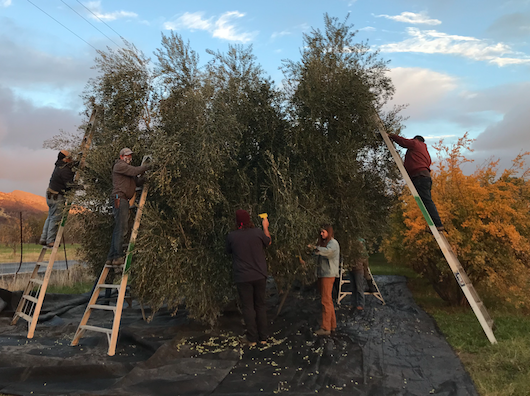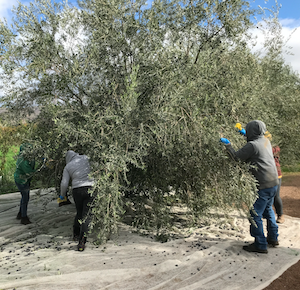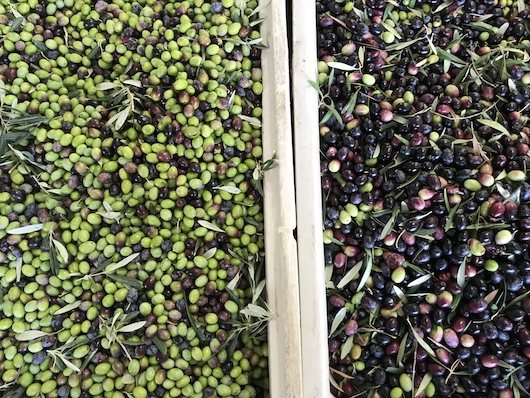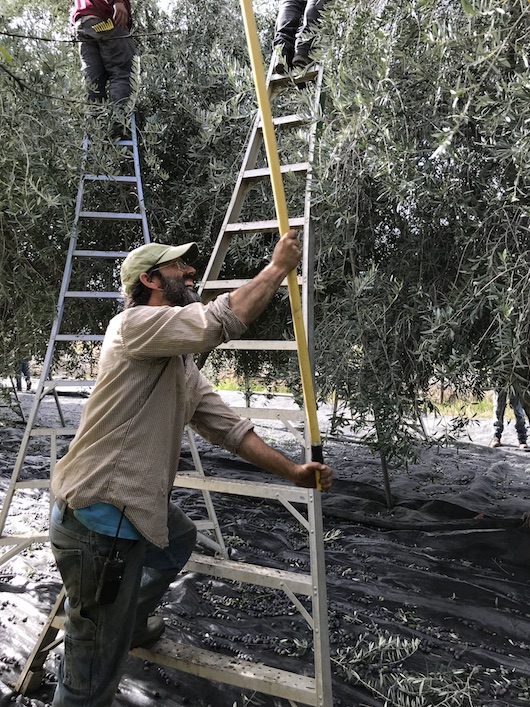
This past Thursday was our 2021 olive harvesting day! It was an all hands on deck effort to get our olives off the trees and turned into olive oil. Even some of us in the office chipped in a bit. A small crew stayed in the wash and pack area to take care of CSA boxes and orders, but everyone else grabbed tarps, ladders, hand rakes, and poles and headed out to the olives in three teams. Each team laid down tarps and then proceeded to pull, rake, and whack all the olives off the trees. Many larger olive oil operations use mechanical shakers to get the olives off of the trees, but we do it by hand. The olives on the tarps are emptied into small harvest bins which were dumped into large macro bins which were ferried back to the shop when full to be kept cool until we finished. It was a long day of work, but it was a true team effort and we had great weather.


For oil, we use both the black and green olives. The black have a higher oil content while the green have a shaper flavor. Even trees next to each other had fairly different ratios of black to green olives.

At the end of the day, Andrew loaded up all 5 tons of olives and brought them down the road to the mill at Seka Hills in Brooks where they were crushed and turned into olive oil, yielding a total of 142 gallons of oil. This yield is a bit lower than what we normally expect (around 35 gallons of oil per ton of olives) likely because the recent rain added a fair amount of water weight, and water is removed during pressing. A quick review of the pressing process: leaves and sticks are removed, olives are washed, the olives are crushed and then the resulting sludge of flesh and pits is slowly churned (malaxing) to allow small oil droplets to form larger ones. That material goes into a centrifuge to separate the oil from the water and solids. Then it’s put into barrels and sent back to us.
It’s crucial that olives are processed as soon as possible after harvesting so it’s good that we have a local place to mill them. Unlike grains or nuts, we can’t let them sit around. Even waiting until the next day is too long. The mill has a minimum milling amount, thus necessitating our one-day harvest.
Once the oil is pressed, minimizing exposure to oxygen, heat, and light are important to keep it fresh. This is why olive oil is usually sold in narrow (less surface exposed to the air) dark (less light) glass (less permeable to oxygen) bottles and recommended storage is in a dark and cool place. Olive oil does not age well so should be enjoyed, not squirreled away for a special occasion.
Extra-virgin olive oil means that the oil is cold-pressed and heat and chemicals weren’t used to extract the oil, it also means that it doesn’t have certain flavor defects. Freshly pressed extra-virgin oil can be quite bitter and spicy. Olive oil is as complex and varied as wine and coffee: olive variety, growing conditions, and processing practices yield very distinctive and different tasting oils. Each oil will have a different flavor profile and may be suited for different uses. Unfortunately, a lot of the oil sold in the US (especially imported oils) is rancid and there’s a substantial amount of fraud regarding the origin and freshness of oils. This means a lot of Americans have exposure to rancid oil, and research has shown that a substantial amount of Americans prefer the taste of rancid oil over the bolder taste of real, and fresh olive oil. The University of California and others provide a substantial research, education, and marketing effort, with the goal of helping consumers identify and appreciate good oil.
Ours is definitely good, fresh oil. But it’s not ready yet! We just got the oil back and need to let it settle for a week or two. We’ll have it bottled up and available for you to enjoy soon. We’ll add it to the web store and announce when it’s ready.
Elaine Swiedler, CSA Manager

